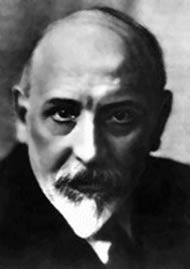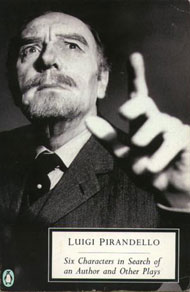
Writing as Exorcism: Luigi Pirandello in VQR

At the height of his fame, Pirandello published an explanatory note on the play in the Italian magazine Comoedia. This note became the preface to the play’s 1925 edition and appeared for the first time in English in VQR. Entitled “Pirandello Confesses … : Why and How He Wrote ‘Six Characters in Search of an Author,’” the piece offers an interesting analogy for imagination. Pirandello writes that his characters come to him through his maid, Fantasia, who “persists in bringing back with her the most disgruntled beings imaginable and filling up my house with them.” Usually, he incorporates these characters into his writing, but he rejects these six particular characters because they lack the universality he requires of subjects. He says in jest, “I have already tormented my readers with hundreds and hundreds of stories […] Why should I bother them with an account of these six unfortunates, and their wretched plight?” Though he rejects these characters, they continue to plead with him to write their story until finally he decides to “represent this unique situation—an author refusing to accept certain characters born of his imagination, while the characters themselves obstinately refuse to be shut out from the world of art, once they have received this gift of life.” Thus, Six Characters in Search of an Author was conceived as an act of writing as exorcism: a final effort to get rid of the rejected characters that haunt him.
Today, Pirandello’s piece in VQR offers valuable insight into his perception of his masterwork. Ann Hallamore Caesar, in her critical study Characters and Authors in Luigi Pirandello (Oxford, 1998), makes the curious observation that, in the essay, Pirandello seems to be distancing himself from his play at the very height of its popularity. His analogy for imagination releases the author from responsibility for creating the characters, and he vigorously denies any resemblance between himself and the character known as The Father. Both of these maneuvers come in addition to the distancing techniques built into Six Characters: the characters are first and foremost rejected characters, and the play-within-a-play structure manages to further separate the author from the sexual transgression that motivates the innermost play.

Penguin edition of Pirandello’s “Six Characters in Search of an Author.”
But why would Pirandello wish to distance himself from his most successful work? Caesar points out the uncomfortable parallel between the six characters’ drama—in which the family reacts to the knowledge that the father has inadvertently purchased sex from his step-daughter—and Pirandello’s own family situation. At the time Pirandello was first visited by the now-notorious six characters, his wife began exhibiting a type of schizophrenia that caused her to become convinced that her husband and daughter were having an affair. These accusations of incest, though unfounded, traumatized the family: his daughter attempted suicide, his wife was committed to a facility, and Pirandello retreated to his writing. If Pirandello distanced himself from his play, perhaps he only meant to distance himself from painful memories of the play’s inspiration: his own family disintegrating because of an alleged sexual scandal.
Whatever Pirandello’s motivations for writing the piece—whether he wanted to protect himself from unflattering comparisons to his traumatized characters or address critics’ and audiences’ misinterpretation of his play—it remains a useful tool for understanding Six Characters and other works such as So It Is (If You Think So) and Henry IV. Though “[t]he mystery of artistic creation” may indeed be “the same mystery as natural birth,” Pirandello attempts here to dispel the mystery, to lay bare the cogs and gears of one artist’s imagination.
- Read “Pirandello Confesses …” from the Spring 1925 issue of VQR.
